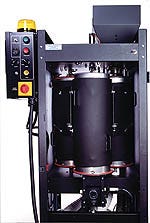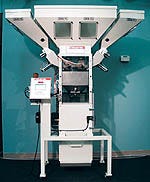K 2001: Auxiliaries make a splash
March 1, 2002
 While there certainly were plenty of auxiliaries on display at K 2001, both in booths and running alongside the many injection molding machines at work during the show, there weren't that many new introductions. Many exhibitors chose, instead, to highlight their workhorses, their established product lines, and simply their company's presence in the market. Still, there were a few noteworthy releases, many of which we have already covered in previous months in IMM's New Product section.
While there certainly were plenty of auxiliaries on display at K 2001, both in booths and running alongside the many injection molding machines at work during the show, there weren't that many new introductions. Many exhibitors chose, instead, to highlight their workhorses, their established product lines, and simply their company's presence in the market. Still, there were a few noteworthy releases, many of which we have already covered in previous months in IMM's New Product section.
Dryers
Perhaps the most eyecatching new product came from Labotek (Rochester, NY), a company that's on a mission to reintroduce itself to the injection molding market with its new interpretation of the dryer. The first thing you notice about Labotek's new series of dry air dryers is the exterior design, which can only be described as futuristic. It comes as no surprise to learn that the company employed an industrial designer to develop the new look.
The initial release of the new Flexible Module Dryer FMD Series includes three mobile, single-bed desiccant dry air units with air flow capacities of 15, 25, or 40 cu m/hr. A modular design allows the units to be combined according to plant requirements and furnished with hoppers of 15, 25, 40, 75, and 100 liters. All units can be equipped with Internet connectivity to allow for external control and remote troubleshooting. Twin desiccant bed units and compressed air drying units will be added to the line soon.
|
|
Labotek employed an industrial designer to give its new line of modular dryers and hoppers a distinctive and somewhat futuristic look. | Maguire returned to K 2001 with its LPD vacuum drying system, which it introduced at NPE 2000. At this year's show the company reported on the success of the technology and introduced a 30-lb/hr unit to the line. |
Maguire (Aston, PA) was back with its Low Pressure Dryer (LPD) technology, which uses a vacuum to dry material. Since its introduction at NPE 2000, more than 100 LPD dryers have reportedly been sold worldwide. These users are said to have reported energy savings upward of 80 percent compared with conventional desiccant dryers. At K 2001, Maguire announced the addition of a 30-lb/hr unit to the LPD line.
Conair highlighted its newest dryer technology for small material throughputs. Three models are available in the Micro D Series with capacities up to 20 kg/hr. The units can be supplied in integral or remote-mounted drying hopper configuration. Also a recent development is the company's S.C. Series, which is suitable for throughputs up to 30 kg/hr. These dryers use an indexing carousel desiccant system adopted from Conair's larger range of D Series dryers. Control is closed loop.
Chillers/Temperature Control
Conair also had news on the chiller front, with three new series of water chillers. The chillers, which were initially released during the summer of 2001, are designed to replace the company's TCA chiller line. The new chillers come in three sizes: the smaller GC Series, the midrange AX Series, and the larger EHP Series.
Though buyers have an option of rotary, piston, or scroll compressors on the GC Series, the AX line now comes standard with scroll compressors, which replace the piston compressors on the TCA range and are said to be more energy efficient. Internal components on all three chiller lines are now stainless steel to eliminate corrosion, and exterior frame design has been strengthened for longer life. A new microprocessor control, said to be accurate to one decimal place, is also now standard.
A new generation of small temperature control units made its debut at the K Show. Regloplas (St. Gallen, Switzerland) introduced Models 90S and P140S, which can be used with water up to 90C and pressurized water up 140C, respectively. The units have maximum heating capacities of 9 kW and cooling capacities of 39 kW.
|
Rapid Granulator's new 10 Series offers circular, toughened cutting wheels that reportedly slice smoothly through even abrasive and filled materials. |
Blenders/Size Reduction
Those looking for a new blender might want to check out Mould-tek's newly redesigned GXB blender. The new design incorporates pinch valve control of minor ingredients. This design, which the company had already employed for the dosing of major ingredients, is said to improve accuracy and reduce materials waste. Under tests, the new blender design reportedly improved dosing accuracy of minor ingredients to within .1 percent. The pinch valve system is also said to increase throughput when compared to a standard auger system.
As usual, granulator manufacturers showed up big at K. Rapid Granulator was among the few, however, that came with new technology to showcase. The company provided the first glimpse of its Concept Granulator, which is said to offer customers the potential for faster material changeover, lower energy consumption, and increased ground material output.
Also new from the company was the 10 Series, which is specifically designed for low-volume grinding of hard, thick-walled, and brittle materials, such as sprues and scrap. The series includes three models, all of which employ rotary cutters and fixed blades designed to produce a uniform 4-mm regrind size. The 10 Series has a low operating speed of 25 rpm. Rotary crusher hooks are used to break up the waste prior to pieces being fed to the toothed cutting wheels.
|
|
Mould-tek's redesigned GXB blender uses a pinch valve system to improve mixing of ingredients. The system reportedly is accurate to within .1 percent. | Bielomatik offers a series of welding machines that allows twin lasers to weld geometries up to 560 by 280 mm. Quasi-simultaneous welding can be used for large industrial parts, like the automotive cockpit assembly shown here, or for smaller components. |
Assembly
For secondary assembly of injection molded parts there were several advancements introduced at K for ultrasonic and hot plate welding. Sonics & Materials highlighted its E Series ultrasonic welder, which incorporates the company's Microsonic processor for more sophisticated control. The controller reportedly improves process control, reduces rejects, and increases throughput. During the welding cycle the processor continually monitors dynamic conditions and automatically adjusts power and time requirements to ensure consistent performance.
Bielomatik showed off its quasi-simultaneous laser welding technique at K, which offers controlled melting off of preforms and joining of surfaces at high speeds. Because of the high traversing rates of the laser beam as it is led along the weld contour, the entire mating surface can be heated up and joined simultaneously. Preform tolerances can be melted off and forced into the weld bead as the two joints are pressed together during welding. The process reportedly allows for the welding of contours with any number of radiuses and corners.
Also new from Bielomatik is a hotplate welding system that is said to leave no wish unfulfilled. The concept was designed to handle highly complex plastic parts that require frequent tool changes. The Servomot system incorporates servomotor-operated axes for improved speed and precision; a fast tool change system; the option of welding without any mechanical limit stops; no hydraulics; maintenance-free moving parts; and process control and monitoring. The concept is based on the company's K2224 machine and has been used to weld the door panels for the limited-edition BMW Z8.
Previous reports on K 2001, including Carl Kirkland's look at machinery trends and Robert Neilley's report on automation, can be found at www.immnet.com. Search for K 2001 in the Article Archive.
You May Also Like







